形容词型分词
- 格式:wps
- 大小:236.00 KB
- 文档页数:55
![形容词、副词__比较级与最高级[1]](https://uimg.taocdn.com/088361fa04a1b0717fd5dd71.webp)
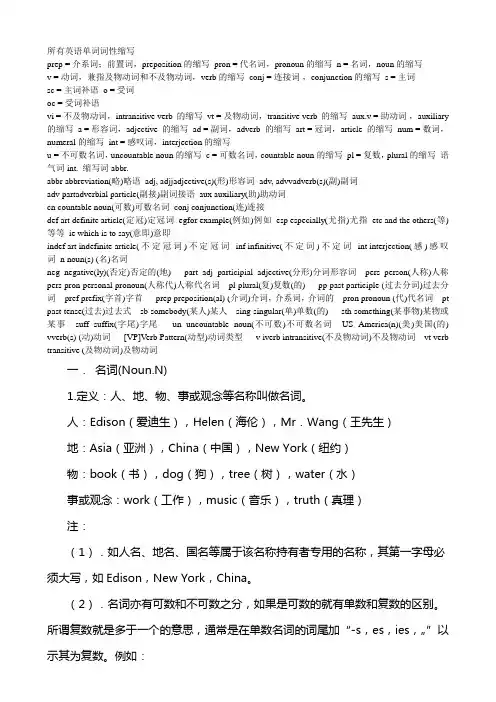
所有英语单词词性缩写prep = 介系词;前置词,preposition的缩写 pron = 代名词,pronoun的缩写 n = 名词,noun的缩写v = 动词,兼指及物动词和不及物动词,verb的缩写 conj = 连接词,conjunction的缩写 s = 主词sc = 主词补语 o = 受词oc = 受词补语vi = 不及物动词,intransitive verb的缩写 vt = 及物动词,transitive verb的缩写 aux.v = 助动词,auxiliary 的缩写 a = 形容词,adjective的缩写 ad = 副词,adverb的缩写 art = 冠词,article的缩写 num = 数词,numeral的缩写 int = 感叹词,interjection的缩写u = 不可数名词,uncountable noun的缩写 c = 可数名词,countable noun的缩写 pl = 复数,plural的缩写语气词 int. 缩写词 abbr.abbr abbreviation(略)略语 adj, adjjadjective(s)(形)形容词 adv, advvadverb(s)(副)副词adv partadverbial particle(副接)副词接语 aux auxiliary(助)助动词cn countable noun(可数)可数名词 conj conjunction(连)连接def art definite article(定冠)定冠词 egfor example(例如)例如 esp especially(尤指)尤指 etc and the others(等)等等 ie which is to say(意即)意即indef art indefinite article(不定冠词)不定冠词 inf infinitive(不定词)不定词 int interjection(感)感叹词 n noun(s) (名)名词neg negative(ly)(否定)否定的(地) part adj participial adjective(分形)分词形容词pers person(人称)人称pers pron personal pronoun(人称代)人称代名词pl plural(复)复数(的) pp past participle (过去分词)过去分词pref prefix(字首)字首prep preposition(al) (介词)介词,介系词,介词的pron pronoun (代)代名词pt past tense(过去)过去式sb somebody(某人)某人sing singular(单)单数(的) sth something(某事物)某物或某事suff suffix(字尾)字尾un uncountable noun(不可数)不可数名词US America(n)(美)美国(的) vverb(s) (动)动词[VP]V erb Pattern(动型)动词类型v iverb intransitive(不及物动词)不及物动词vt verb transitive (及物动词)及物动词一.名词(Noun.N)1.定义:人、地、物、事或观念等名称叫做名词。
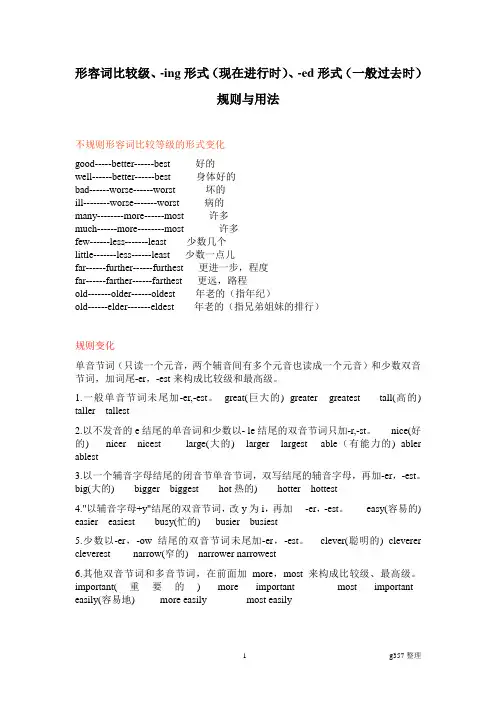
形容词比较级、-ing形式(现在进行时)、-ed形式(一般过去时)规则与用法不规则形容词比较等级的形式变化good-----better------best 好的well------better------best 身体好的bad------worse------worst 坏的ill--------worse-------worst 病的many--------more------most 许多much------more--------most 许多few------less-------least 少数几个little-------less------least 少数一点儿far------further------furthest 更进一步,程度far------farther------farthest 更远,路程old-------older------oldest 年老的(指年纪)old------elder-------eldest 年老的(指兄弟姐妹的排行)规则变化单音节词(只读一个元音,两个辅音间有多个元音也读成一个元音)和少数双音节词,加词尾-er,-est来构成比较级和最高级。
1.一般单音节词未尾加-er,-est。
great(巨大的) greater greatest tall(高的) taller tallest2.以不发音的e结尾的单音词和少数以- le结尾的双音节词只加-r,-st。
nice(好的) nicer nicest large(大的) larger largest able(有能力的) abler ablest3.以一个辅音字母结尾的闭音节单音节词,双写结尾的辅音字母,再加-er,-est。
big(大的) bigger biggest hot热的) hotter hottest4."以辅音字母+y"结尾的双音节词,改y为i,再加-er,-est。

形容词比较级、-ing形式(现在进行时)、-ed形式(一般过去时)规则与用法不规则形容词比较等级的形式变化good-----better------best 好的well------better------best 身体好的bad------worse------worst 坏的ill--------worse-------worst 病的many--------more------most 许多much------more--------most 许多few------less-------least 少数几个little-------less------least 少数一点儿far------further------furthest 更进一步,程度far------farther------farthest 更远,路程old-------older------oldest 年老的(指年纪)old------elder-------eldest 年老的(指兄弟姐妹的排行)规则变化单音节词(只读一个元音,两个辅音间有多个元音也读成一个元音)和少数双音节词,加词尾-er,-est来构成比较级和最高级。
1.一般单音节词未尾加-er,-est。
great(巨大的) greater greatest tall(高的) taller tallest2.以不发音的e结尾的单音词和少数以- le结尾的双音节词只加-r,-st。
nice(好的) nicer nicest large(大的) larger largest able(有能力的) abler ablest3.以一个辅音字母结尾的闭音节单音节词,双写结尾的辅音字母,再加-er,-est。
big(大的) bigger biggest hot热的) hotter hottest4."以辅音字母+y"结尾的双音节词,改y为i,再加-er,-est。
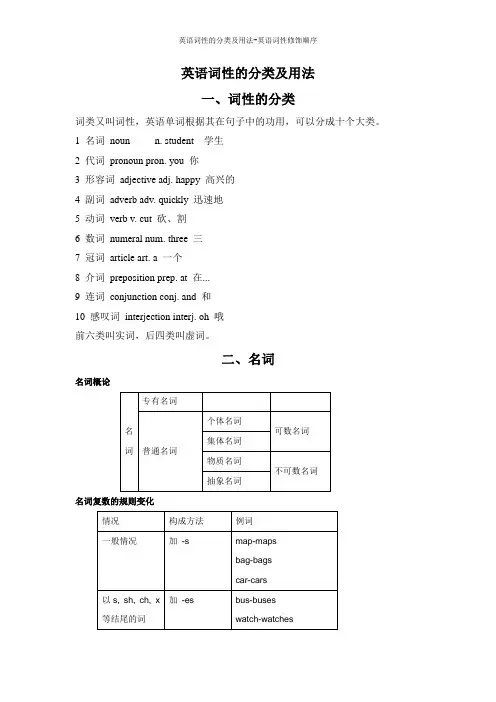
英语词性的分类及用法一、词性的分类词类又叫词性,英语单词根据其在句子中的功用,可以分成十个大类。
1 名词noun n. student 学生2 代词pronoun pron. you 你3 形容词adjective adj. happy 高兴的4 副词adverb adv. quickly 迅速地5 动词verb v. cut 砍、割6 数词numeral num. three 三7 冠词article art. a 一个8 介词preposition prep. at 在...9 连词conjunction conj. and 和10 感叹词interjection interj. oh 哦前六类叫实词,后四类叫虚词。
二、名词名词概论名词复数的规则变化名词的格在英语中有些名词可以加"'s"来表示所有关系,带这种词尾的名词形式称为该名词的所有格,如:a teacher's book。
名词所有格的规则如下:1)单数名词词尾加"'s",复数名词词尾没有s,也要加"'s",如the boy's bag 男孩的书包,men's room 男厕所。
2)若名词已有复数词尾-s ,只加"'",如:the workers' struggle工人的斗争。
3)凡不能加"'s"的名词,都可以用"名词+of +名词"的结构来表示所有关系,如:the title of the song 歌的名字。
4)在表示店铺或教堂的名字或某人的家时,名词所有格的后面常常不出现它所修饰的名词,如:the barber's 理发店。
5)如果两个名词并列,并且分别有's,则表示"分别有";只有一个's,则表示'共有'。
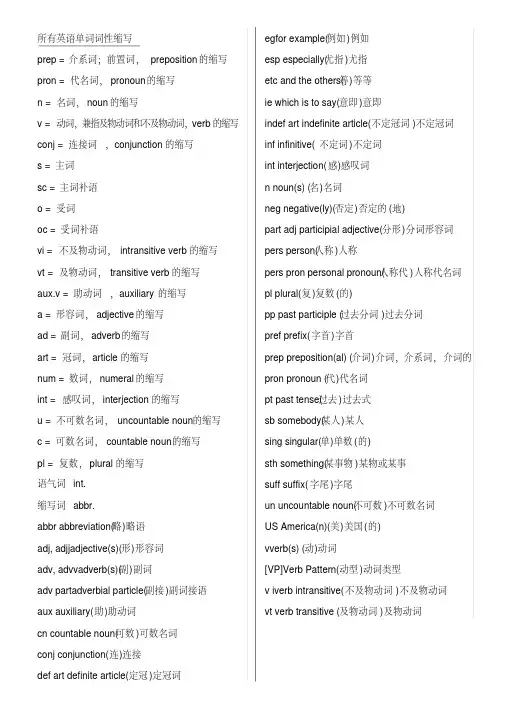
所有英语单词词性缩写prep = 介系词;前置词,preposition的缩写pron = 代名词,pronoun的缩写n = 名词,noun的缩写v = 动词,兼指及物动词和不及物动词,verb的缩写conj = 连接词,conjunction的缩写s = 主词sc = 主词补语o = 受词oc = 受词补语vi = 不及物动词,intransitive verb的缩写vt = 及物动词,transitive verb的缩写aux.v = 助动词,auxiliary的缩写a = 形容词,adjective的缩写ad = 副词,adverb的缩写art = 冠词,article的缩写num = 数词,numeral的缩写int = 感叹词,interjection的缩写u = 不可数名词,uncountable noun的缩写c = 可数名词,countable noun的缩写pl = 复数,plural的缩写语气词int.缩写词abbr.abbr abbreviation(略)略语adj, adjjadjective(s)(形)形容词adv, advvadverb(s)(副)副词adv partadverbial particle(副接)副词接语aux auxiliary(助)助动词cn countable noun(可数)可数名词conj conjunction(连)连接def art definite article(定冠)定冠词egfor example(例如)例如esp especially(尤指)尤指etc and the others(等)等等ie which is to say(意即)意即indef art indefinite article(不定冠词)不定冠词inf infinitive(不定词)不定词int interjection(感)感叹词n noun(s) (名)名词neg negative(ly)(否定)否定的(地)part adj participial adjective(分形)分词形容词pers person(人称)人称pers pron personal pronoun(人称代)人称代名词pl plural(复)复数(的)pp past participle (过去分词)过去分词pref prefix(字首)字首prep preposition(al) (介词)介词,介系词,介词的pron pronoun (代)代名词pt past tense(过去)过去式sb somebody(某人)某人sing singular(单)单数(的)sth something(某事物)某物或某事suff suffix(字尾)字尾un uncountable noun(不可数)不可数名词US America(n)(美)美国(的)vverb(s) (动)动词[VP]Verb Pattern(动型)动词类型v iverb intransitive(不及物动词)不及物动词vt verb transitive (及物动词)及物动词。
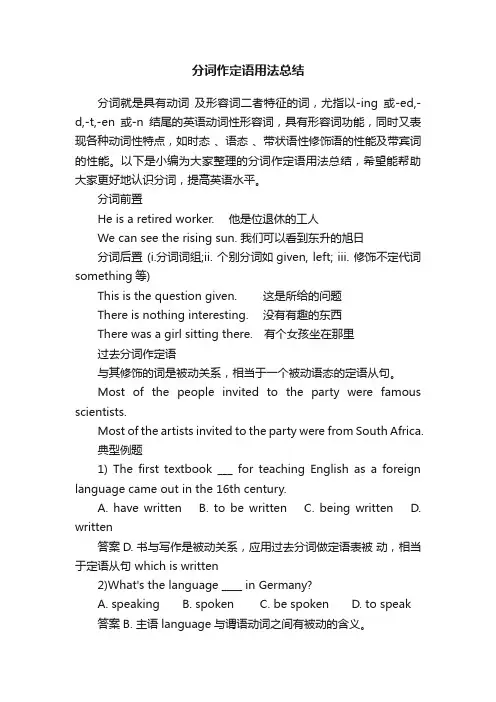
分词作定语用法总结分词就是具有动词及形容词二者特征的词,尤指以-ing或-ed,-d,-t,-en或-n结尾的英语动词性形容词,具有形容词功能,同时又表现各种动词性特点,如时态、语态、带状语性修饰语的性能及带宾词的性能。
以下是小编为大家整理的分词作定语用法总结,希望能帮助大家更好地认识分词,提高英语水平。
分词前置He is a retired worker. 他是位退休的工人We can see the rising sun. 我们可以看到东升的旭日分词后置 (i.分词词组;ii. 个别分词如given, left; iii. 修饰不定代词something等)This is the question given. 这是所给的问题There is nothing interesting. 没有有趣的东西There was a girl sitting there. 有个女孩坐在那里过去分词作定语与其修饰的词是被动关系,相当于一个被动语态的定语从句。
Most of the people invited to the party were famous scientists.Most of the artists invited to the party were from South Africa.典型例题1) The first textbook ___ for teaching English as a foreign language came out in the 16th century.A. have writtenB. to be writtenC. being writtenD. written答案D. 书与写作是被动关系,应用过去分词做定语表被动,相当于定语从句 which is written2)What's the language ____ in Germany?A. speakingB. spokenC. be spokenD. to speak答案B. 主语language与谓语动词之间有被动的含义。
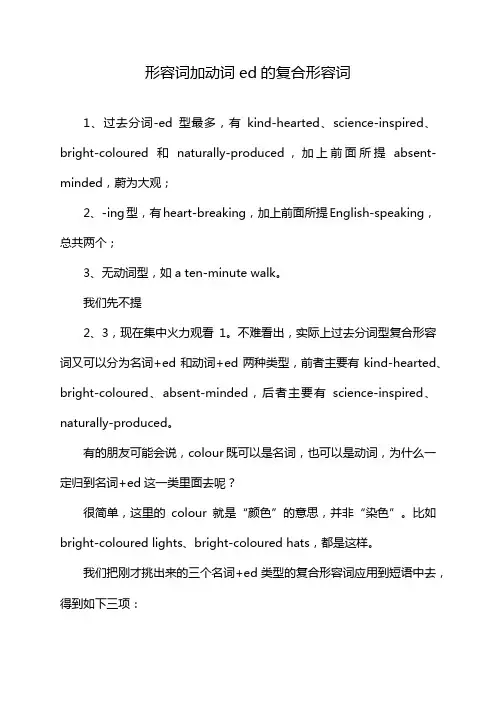
形容词加动词ed的复合形容词1、过去分词-ed型最多,有kind-hearted、science-inspired、bright-coloured和naturally-produced,加上前面所提absent-minded,蔚为大观;2、-ing型,有heart-breaking,加上前面所提English-speaking,总共两个;3、无动词型,如a ten-minute walk。
我们先不提2、3,现在集中火力观看1。
不难看出,实际上过去分词型复合形容词又可以分为名词+ed和动词+ed两种类型,前者主要有kind-hearted、bright-coloured、absent-minded,后者主要有science-inspired、naturally-produced。
有的朋友可能会说,colour既可以是名词,也可以是动词,为什么一定归到名词+ed这一类里面去呢?很简单,这里的colour就是“颜色”的意思,并非“染色”。
比如bright-coloured lights、bright-coloured hats,都是这样。
我们把刚才挑出来的三个名词+ed类型的复合形容词应用到短语中去,得到如下三项:kind-hearted people 好心人bright-coloured lights 颜色鲜艳的灯an absent-minded student 一名心不在焉的学生我把上面三个短语中的中心名词都用黑体表示了。
显然,加了-ed词尾的heart、colour和mind,分别是people、lights和student的一个组成部分,一个部件。
上述三个短语可以分别解释为:people who have kind heartslights which have bright coloursa student who has an absent mind由此,我们可以得出一个结论:“形容词+名词-ed”形式的复合形容词,一般是表示人或物的某组成部分(部件)所具备的品质。
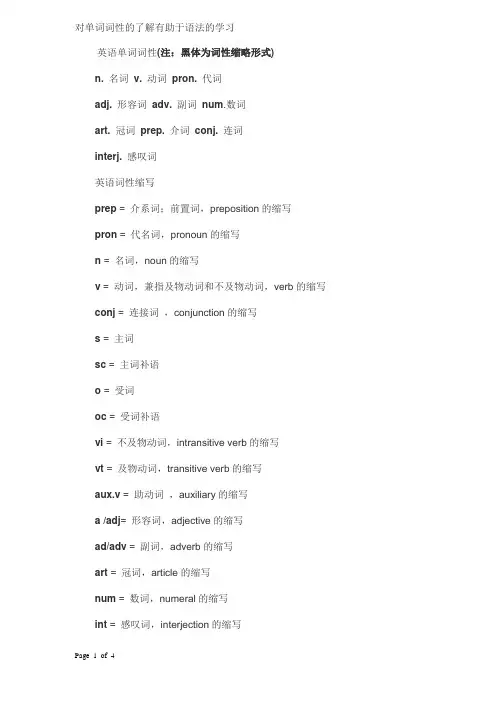
对单词词性的了解有助于语法的学习英语单词词性(注:黑体为词性缩略形式)n. 名词v.动词pron.代词adj. 形容词adv.副词num.数词art.冠词prep.介词conj. 连词interj. 感叹词英语词性缩写prep = 介系词;前置词,preposition的缩写pron = 代名词,pronoun的缩写n = 名词,noun的缩写v = 动词,兼指及物动词和不及物动词,verb的缩写conj = 连接词,conjunction的缩写s = 主词sc = 主词补语o = 受词oc = 受词补语vi = 不及物动词,intransitive verb的缩写vt = 及物动词,transitive verb的缩写aux.v = 助动词,auxiliary的缩写a /adj= 形容词,adjective的缩写ad/adv = 副词,adverb的缩写art = 冠词,article的缩写num = 数词,numeral的缩写int = 感叹词,interjection的缩写u = 不可数名词,uncountable noun的缩写c = 可数名词,countable noun的缩写pl = 复数,plural的缩写语气词int.缩写词abbr.abbr abbreviation(略)略语adj, adjjadjective(s)(形)形容词adv, advvadverb(s)(副)副词adv partadverbial particle(副接)副词接语aux auxiliary(助)助动词cn countable noun(可数)可数名词conj conjunction(连)连接def art definite article(定冠)定冠词eg./egfor example(例如)例如esp especially(尤指)尤指etc and the others(等)等等ie which is to say(意即)意即indef art indefinite article(不定冠词)不定冠词inf infinitive(不定词)不定词int interjection(感)感叹词n noun(s) (名)名词neg negative(ly)(否定)否定的(地)part adj participial adjective(分形)分词形容词pers person(人称)人称pers pron personal pronoun(人称代)人称代名词pl plural(复)复数(的)pp past participle (过去分词)过去分词pref prefix(字首)字首prep preposition(al) (介词)介词,介系词,介词的pron pronoun (代)代名词pt past tense(过去)过去式sb somebody(某人)某人sing singular(单)单数(的)sth something(某事物)某物或某事suff suffix(字尾)字尾un uncountable noun(不可数)不可数名词US America(n)(美)美国(的)v.verb(s) (动)动词[VP]Verb Pattern(动型)动词类型vi .verb intransitive(不及物动词)不及物动词vt. verb transitive (及物动词)及物动词除这十大类词之外,英语还另有判断词yes和no。
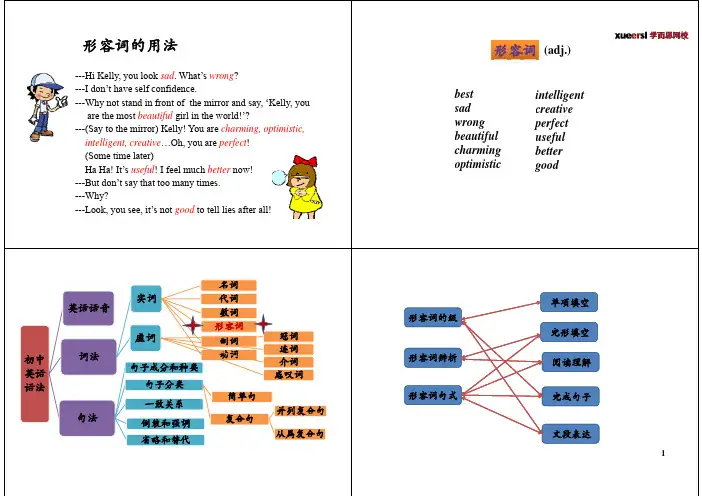
to tell lies after all!intelligent creative perfect useful better beautiful charming goodoptimistic状态a-/ab-atypical, abnormal典anti-anti-government, anti-socialdis-dishonest, disagreeable, disloyal型形il-illegal, illogical, illiterateim-impossible, impolite, impersonal容词in-inactive, incorrect, indirectir-irrespective, irregular前缀non-non-essential, non-electricalun-unhappy, unfair,unkind,uncertainppy,,,snow-white, ice-cold easy-going, hard-workingh d k well-known, half-donefull-time,two-weekeight-year-oldface-to-face,heart-to-heart English-speakingglass-topped, man-made kind-hearted宾定状补.interesting . g student comes from Japan.系动词句分类系动词例句状态become,go,run,Fish soon bad in hot weather.状态变化become, go, run, grow Fish soon goes bad in hot weather. His cold was growing worse . come get prove What he had hoped at last came true 变化结果come, get, prove,turn What he had hoped at last came true . The article has proved most useful . Blood is thicker than water状态beBlood is thicker than water. 保持状keep,remain, rest,stand stay We should keep silent in the library. The shop stays open until nine o’clock 态stand, stay The shop stays open until nine o clock.感官性look,smell, taste, sound feel Silk feels soft and smooth .medicine tastes horrible sound, feel This medicine tastes horrible .宾定状补【重点句型】◆宾定状补4.状语时间状语)Breathless, she rushed in through the back door.(伴随状语)5.作主语The old should be taken good care of.形容词的名词形容词的名词化表定表定互换to drink?long.小木质盒子里放着年长的姐姐送的唯一的羊毛衫) little, wooden, elder, only, woolen afraid ill 5a ,健康还是生病,别怕!alone asleep k ()awake alivewellfrightened. (√ ) 美小圆旧红,法国木书房颜国材名名大小形状和新老,颜色国籍出(处)材料This ______ girl is Linda’s cousin.B. Spanish little prettyD. little pretty Spanish p y pfor / of sb. to do sth.for students to be creative.To be creative is very important (for students).()to do sth. (that + 句子)to fall asleep at night.that Xiao Wang did not come yesterday.g y yenough to do sth.that she can not climb the stairs.倒装句应用(写作中高级句型)引导的让步状语从句as it is, the children play outdoors.though he is, the scientist works hard.位于句首时was he that he did not dare to move an inch.not dare to move an inch.was she that she couldn’t speak.。
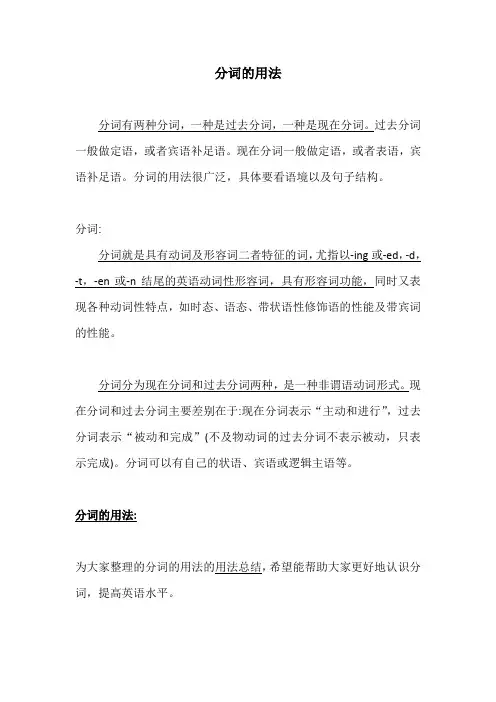
分词的用法分词有两种分词,一种是过去分词,一种是现在分词。
过去分词一般做定语,或者宾语补足语。
现在分词一般做定语,或者表语,宾语补足语。
分词的用法很广泛,具体要看语境以及句子结构。
分词:分词就是具有动词及形容词二者特征的词,尤指以-ing或-ed,-d,-t,-en或-n结尾的英语动词性形容词,具有形容词功能,同时又表现各种动词性特点,如时态、语态、带状语性修饰语的性能及带宾词的性能。
分词分为现在分词和过去分词两种,是一种非谓语动词形式。
现在分词和过去分词主要差别在于:现在分词表示“主动和进行”,过去分词表示“被动和完成”(不及物动词的过去分词不表示被动,只表示完成)。
分词可以有自己的状语、宾语或逻辑主语等。
分词的用法:为大家整理的分词的用法的用法总结,希望能帮助大家更好地认识分词,提高英语水平。
分词作定语分词前置We can see the rising sun. 我们可以看到东升的旭日He is a retired worker.他是位退休的工人分词后置(i分词词组;ii 个别分词如given, left; iii 修饰不定代词something等)There was a girl sitting there.有个女孩坐在那里There is nothing interesting.没有有趣的东西This is the question given.这是所给的问题过去分词作定语与其修饰的词是被动关系,相当于一个被动语态的定语从句。
Most of the people invited to the party were famous scientists.Most of the artists invited to the party were from South Africa.典型例题1)What"s the language ____ in Germany?A. speakingB. spokenC. be spokenD. to speak答案B. 主语language与谓语动词之间有被动的含义。
形容词,英语语法英语语法-形容词You'd better tell us something interesting.The police found nothing strange in the room3.以-ly结尾的形容词1)大部分形容词加-ly可构成副词。
但 friendly,deadly,lovely,lonely,likely,lively,ugly,brotherly,仍为形容词。
2)有些以-ly 结尾既为形容词,也为副词,如daily,weekly,monthly,yearly,early等。
例如: The Times is a weekly paper. 《时代周刊》为周刊。
The Times is published weekly. 《时代周刊》每周发行一期。
3)有些既可以作形容词也可作副词。
deep ,fast ,far ,high ,late, much, well ,wideThis is a fast train.Li Ming runs very fast.4.典型例题:1) One day they crossed the ____bridge behind the palace.A. old Chinese stoneB. Chinese old stoneC. old stone ChineseD. Chinese stone old A. 几个形容词修饰一个名词,他们的排列顺序是:年龄,形状,大小+颜色++质地+用途+国家+名词。
2) ---- How was your recent visit to Qingdao?---- It was great. We visited some friends,and spent the ___days at the seaside.A. few last sunnyB. last few sunnyC. last sunny fewD. few sunny last答案:B。
英语形容词排列顺序英语形容词排列顺序一直是一个比较复杂的问题,很多英语学习者发现难以找到适合自己的记忆方法。
为此,我特地从网上找到了一些帮助记忆的方法,仅供参考。
一、最简单的!大小、长短、形状+年龄、新旧+颜色+国籍、出处+材料+用途、类别二、比较实用,又好记忆!大哥限描大,二哥形龄颜,小弟籍物类,同站名词前。
分别解释为:限:限定词。
the, my, a,this…描:描绘性形容词。
brave, beautiful, lovely,nice…大:大小、高低、长短等形容词。
big,large,small…形:形状。
round,square…龄:年龄大小、新旧、年代等。
young,old,new…颜:颜色。
red,blue,green…籍:国籍、地区、出处。
Chinese,America,Japanese…物:物质材料的形容词。
golden,wooden,wax…类:表示类别、用途。
medical,chemical,writing…一个旧的很漂亮的黑色的日本式的方形木制小写字桌A pretty little square old black Japanese wooden writing desk.一件漂亮的中式新的短装红羊毛外套A beautiful short new red Chinese woollen coat.三、巧记形容词排列顺序请看下面一道高考题:This____girl Linda"s conusin.(2005北京卷)A. pretty little SpanishB. Spanish little prettyC. Spanish prettyD. liite pretty Spanish此题选A。
该题时对形容词排列顺序的考察。
在英语中,当名词有多个形容词修饰时,就有它们的先后顺序。
下面的口诀可帮你记住这一先后顺序,也是解题的关键。
限定描绘大长高,形状年龄和新老;颜色国籍跟材料,作用类别往后排;其中,“限定词”包括:冠词、物主代词、指示代词、或数词,它位于各类形容词前。
形容词作定语时的排序问题一般遵从如下规律: 如果两个以上的形容词修饰一个名词时,与被修饰的名词关系较密切的形容词靠近名词;如果几个形容词的密切程度差不多,则音节少的形容词在前,音节多的在后。
如: a small wonderful gift。
英语形容词排列顺序一直是一个比较复杂的问题,很多英语学习者发现难以找到适合自己的记忆方法。
一、最简单的!大小、长短、形状+年龄、新旧+颜色+国籍、出处+材料+用途、类别二、比较实用,又好记忆!大哥限描大,二哥形龄颜,小弟籍物类,同站名词前。
分别解释为:限:限定词。
the, my, a, this…描:描绘性形容词。
brave, beautiful, lovely, nice…大:大小、高低、长短等形容词。
big,large,small…形:形状。
round,square…龄:年龄大小、新旧、年代等。
young,old,new…颜:颜色。
red,blue,green…籍:国籍、地区、出处。
Chinese,America,Japanese…物:物质材料的形容词。
golden,wooden,wax…类:表示类别、用途。
medical,chemical,writing…一个旧的很漂亮的黑色的日本式的方形木制小写字桌A pretty little square old black Japanese wooden writing desk.一件漂亮的中式新的短装红羊毛外套A beautiful short new red Chinese woollen coat.三、巧记形容词排列顺序 在英语中,当名词有多个形容词修饰时,就有它们的先后顺序。
下面的口诀可帮你记住这一先后顺序,也是解题的关键。
限定描绘大长高,形状年龄和新老;颜色国籍跟材料,作用类别往后排; 其中,“限定词”包括:冠词、物主代词、指示代词、或数词,它位于各类形容词前。
它本身分为三位,即:前、中、后。
前位限定词有all、half、both、分数和倍数;中位限定词有冠词、指示代词、物主代词等;后位限定词有基数词和序数词,但序数词位于基数词前。
英语词性的分类及用法一、词性的分类词类又叫词性,英语单词根据其在句子中的功用,可以分成十个大类。
1 名词noun n. student 学生2 代词pronoun pron. you 你3 形容词adjective adj. happy 高兴的4 副词adverb adv. quickly 迅速地5 动词verb v. cut 砍、割6 数词numeral num. three 三7 冠词article art. a 一个8 介词preposition prep. at 在...9 连词conjunction conj. and 和10 感叹词interjection interj. oh 哦前六类叫实词,后四类叫虚词。
二、名词名词概论名词复数的规则变化名词的格在英语中有些名词可以加"'s"来表示所有关系,带这种词尾的名词形式称为该名词的所有格,如:a teacher's book。
名词所有格的规则如下:1)单数名词词尾加"'s",复数名词词尾没有s,也要加"'s",如the boy's bag 男孩的书包,men's room 男厕所。
2)若名词已有复数词尾-s ,只加"'",如:the workers' struggle工人的斗争。
3)凡不能加"'s"的名词,都可以用"名词+of +名词"的结构来表示所有关系,如:the title of the song 歌的名字。
4)在表示店铺或教堂的名字或某人的家时,名词所有格的后面常常不出现它所修饰的名词,如:the barber's 理发店。
5)如果两个名词并列,并且分别有's,则表示"分别有";只有一个's,则表示'共有'。
英语形容词口诀口诀一:美小圆旧黄,中国木书房词性解释:形容词是用来描述人或事物的性质、状态、属性或特征的词类。
意思:“美”指描述或性质类形容词,如beautiful;“小”指大小、长短等形容词,像small;“圆”代表形状类形容词,如round;“旧”是新旧、年龄类形容词,如old;“黄”为颜色类形容词,像yellow;“中国”表示来源、国籍等类形容词,如Chinese;“木”指物质、材料类形容词,如wooden;“书房”可理解为用途、类别类形容词,类似writing 等。
用法:一般放在名词前作定语,用来修饰限定名词,使名词的描述更具体、更丰富。
比如,a beautiful flower 一朵美丽的花,“beautiful”修饰“flower”,让我们更清楚花的特征。
近义词:nice 与beautiful 相近,都有“美好的”意思;little 可作为small 的近义词,都表示“小的”。
双语例句:Look at that beautiful flower. It's really charming. 看那朵美丽的花,它真的很迷人。
I have a small box. It's very cute. 我有一个小盒子,它很可爱。
口诀二:县官行令杀国材词性解释:同上述,形容词主要对名词起到修饰、描绘等作用,展现其不同方面的特点。
意思:“县”指限定词,像the、my、a 等;“官”指冠词;“行”表示性质的定语,即描述性形容词;“令”表示年龄;“杀”表示颜色;“国”表示国籍;“材”表示材料。
用法:根据其修饰的名词及表达的需要,选择合适的形容词放在名词前,按照口诀顺序排列,使表达更准确、更符合英语的表达习惯。
例如,those old red Chinese wooden houses 那些旧的红色的中国木制房子。
近义词:elderly 可作为old 的近义词,意为“年长的”;national 可与Chinese 等国籍类形容词类似,指“国家的”。
形容词型分词记得前两天有旺友问“动词+ed"作形容词的问题,刚好张道真的一本语法书上有很详细的介绍,准备把它拿到这和大家共享。
有点长,而我打字又慢,慢慢输吧,争取在7-10天内完成:)起形容词作用的分词(形容词型分词)a. 分词作定语的用法1)总的特点分词可以作定语,修饰或是限制一个名词,可以放在它前面,也可以放在它后面。
一般说来,简单分词可以放在名词前面,分词短语放在名词后面。
a)放在名词前面的分词1/表示动作的分词:一个现在分词或过去分词放在名词前时,可以表示一时的动作,这时它的动词特点胜过形容词特点,相当于一个定语从句Do you see the rising sun(=sun which is rising) in the east?They tried to surround the retreating troops (=troops which were retreating).The roaring lion frightened all the animals in the jungle.They tried to deliver the besieged city (=city which was being besieged).These repeated efforts(=efforts which were being repeated) were still inadequate.Those oppressed nations (=nations that are being oppressed ) are rising to liberate themselves.2/表示特点的分词:它也可以表示比较长久或永久性的特点。
这时它的形容词特点胜过它的动词特点:Germs are living creatures (=not inanimate things, creatures that can live).She is a charming lady (attractive lady, lady who charms others)The working classes are usually poor.There were many flying fish.We watched the moving pictures (=motion pictures)Used cars (=old cars,cars which have been used) are cheaper than new ones/Stolen love (=Secret love, love which is stolen), though dangerous, tastes exceptionally sweet.This printed matter may be sent by mail.3/和用作形容词的动名词的差别:用在名词前的现在分词和用在名词前起形容词作用的动名词是有区别的,从意思上、重音上及是否加连字号,都有区别。
下面各对句子中,第一句中带-ing词尾的动词为分词,第二句中带-ing词尾的动词为动名词:Boiling water(=Water that is boiling) can produce enormous power.Water begins to boil at the boiling-point(=point at which liquid boils;而不是point which boils).He is a walking dictionary (=dictionary that canwalk,learned man).He came with a walking-stick (=stick for walking;非stick that os walking)How clever that dancing bear (=bear that is dancing) is!He is a dancing-master (=master who teaches dancing).Someone said many years ago thatChinawas a sleeping lion (=lion that was sleeping).He is in the sleeping-car (=car for sleeping,而不是 car that is sleeping).Running water is cleaner than stagnant water.It is a running-track for sportsmen.4/用作名词的情况和形容词一样,某些分词在加the时(后面不跟名词),可以代表一类人或一种抽象东西:Which are more numerous, the dead or the living (=the living people)Something must be done immediately with the wounded and the dying.What should we do with the oppressed, the defeated the insulted and the injured?Can we say anything about the unseen (=the thing unseen) and the unknown (=the thing unknown)?放在名词后的分词放在名词后的分词多数是分词短语,它可以变成一个定语从句(尽管定语从句不一定都能变成分词短语):1/表示一时动作的分词短语:The danger threatening the world (=which is threatening the area ) is too many people with too little food.They looked on at the city being attacked by the enemy (=which was being attacked by the enemy).The man being followed by guards (=who are being followed by guards) is a party leader.2/表示长久特点的分词短语:A man respecting others (=who respects others ) will be respected.Can you teach a boy refusing to be taught (=who refuses to be taught)?It is difficult to save a man enchanted by the beauty of a woman.Books called the comics (=that are called the comics ) are sometimes harmful to children.Any books well read (=that are well read ) are good books and any men well treated are good men.名词前作定语的分词a)用在名词前的不及物现在分词名词前的现在分词多数为不及物动词:The trembling criminal hung his head.Do you see the floating bridge there?She is a doting mother.The existing situation will last some years.In the field are nodding trees, murmuring rivulets, smiling flowers, singing birds, swimming ducks and playing children.He is an uncompromising diplomat.It proves futile in spite of all untiring efforts.This upright man always takes an unswerving course.It is an unavailing plot.There is an undying friendship between them.b)用在名词前的及物现在分词1/意义上的宾语为‘人’的情况:及物动词的分词也可用在名词前面,但它们大多表示情绪。
它们的意义上的宾语指一般人或某些人,是不说出的。
It is a charming story=It is a story that charms us (me,you or anyone).We have an encouraging prospect. =We have a prospectthat encourages us.This exciting experience made him sleepless. =This experience, which excited him, made him sleepless.It is an interesting (or surprising, amazing, moving, entertaining, affecting ) story.He has a puzzling problem to solve.In the forest there happened a shocking (or frightening ) case of murder.Her fascinating eyes and her tempting mouth put you in a reverie.It is a misleading statement, a deceiving promise.An unconvincing rumor spread over the city.2/意义上的宾语为‘物’的情况:有少数及物动词的分词,它们的意义上的宾语也不说出,却是指‘物’的,这时要经过琢磨才知道宾语是什么:It is an arresting sight (=a sight that arrests somebody's attention), an imploring look (=a look that implores somebody's help), a revealing story (= a story that reveals things hidden or kept secret), a deserving cause (=a cause that deserves sympathy or help).He is a grasping attorney (an attorney who are eagerto grasp money).A knowing man (=a man who knows all the secret),an understanding man (a man who understands others' feelings),a forbidding headmaster (=a headmaster who forbids others to approach or to like him),a loving father (=a father who loves children or others),a promising youth (a youth who promises to suceed), a designing businessman (=a bisinessman who designssome intrigues),an unfeeling judge (=judge who feels no sympathy),an unforgiving father (=a father who does not forgive any fault),an unthinking playboy(=a playboy who does not think of the consequences)an unsparing housewife (=housewilfe who does not spare money),an unassuming scholar (=a scholar who does not assume importance),an unpretending manager (=a manager who does not pretend importance).c)用在名词前的及物过去分词1/一般过去分词:及物动词的过去分词常可用在名词前作它的修饰语。